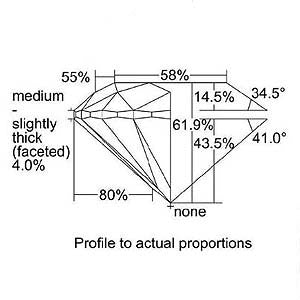
Why are Brian Gavin Signature diamonds so expensive?
Every one of the reviews which I’ve read about Brian Gavin Signature diamonds indicates that they are amazing, everybody who has purchased one seems to just rave about how bright and sparkly they are, so I’m definitely interested in possibly buying one, however I’m trying to figure out why Brian Gavin Signature diamonds are so expensive compared to other ideal cut diamonds that I find online. For instance, this 2.106 carat, I-color, VS-1 clarity, BGD Signature round diamond is several thousand dollars more expensive than this 2.02 carat, I-color, VS-1 clarity, round ideal cut diamond that I found from
and I’ve read that AGS Ideal and GIA Excellent are pretty much the same thing, so what’s the deal? Am I just paying more for the Brian Gavin name? Or is there a legitimate reason why Brian Gavin Signature diamonds are better than other signature ideal cut diamonds? – Anthony R.
AGS Ideal vs GIA Excellent overall cut grades:
 Let’s begin by destroying the myth that the overall cut grade of GIA Excellent is the same as AGS Ideal, because the reality is that the range of proportions is dramatically different for the GIA Excellent and AGS Ideal-0 proportions ratings; and only the AGS Laboratory uses Angular Spectrum Evaluation Technology (ASET) to measure the brightness of the diamonds which they grade, and to demonstrate how light is moving through the diamond. The ASET diagram featured to the left, demonstrates the levels of brightness exhibited by the 2.106 carat, I-color, VS-1 clarity, Brian Gavin Signature round diamond that you are considering, however there is no way of knowing how the GIA graded diamond would fair.
Let’s begin by destroying the myth that the overall cut grade of GIA Excellent is the same as AGS Ideal, because the reality is that the range of proportions is dramatically different for the GIA Excellent and AGS Ideal-0 proportions ratings; and only the AGS Laboratory uses Angular Spectrum Evaluation Technology (ASET) to measure the brightness of the diamonds which they grade, and to demonstrate how light is moving through the diamond. The ASET diagram featured to the left, demonstrates the levels of brightness exhibited by the 2.106 carat, I-color, VS-1 clarity, Brian Gavin Signature round diamond that you are considering, however there is no way of knowing how the GIA graded diamond would fair.
Is a two carat diamond worth the premium?
One of the factors to consider when buying a diamond that is close to the mark in terms of carat weight is whether the diamond cheated the stone by cutting it deeper than it needed to be, in order to push the carat weight up and over the mark that defines the edge of each price tier.
If I run the dimensions of the 2.02 carat diamond which you inquired about from the other dealer through a standard formula which is used to estimate the weight of a round brilliant cut diamond, the estimated carat weight of the diamond is only 1.988 carats, and thus while you are paying a premium for a diamond that technically weighs 2.02 carats, you are buying a diamond that faces-up like a diamond that weighs 1.99 carats.
While this slight difference in carat weight might seem inconsequential at first glance, keep in mind that there is a major price increase that occurs in the price of diamonds between the 1.99 – 2.00 carat marks, thus if you were to actually buy a diamond that was properly proportioned and which weighed 1.988 carats, you’d pay about $7,400.00 less for a diamond of the same color and clarity grade.
So while it might seem like the Brian Gavin Signature round diamond is more expensive than the other 2.02 carat round diamond that you are considering, the reality is that the Brian Gavin Signature diamond faces up the same size as the dimensions indicate that it should, because it is properly proportioned, and thus it actually provides the best value, because you are getting a diamond which provides the visible diameter that you are paying a premium for.
 In addition, when I look at the proportions of the 2.02 carat round diamond that you referred to, the first thing that I notice is that the relationship between the crown height of the diamond (14.5%) and the crown angle are out of balance; likewise the 43.5% pavilion depth is too steep for a pavilion angle of 41.0 degrees; and both of these factors will affect the volume of light return exhibited by the diamond, as well as how light travels through the diamond, and the overall sparkle factor. Of critical importance is the average pavilion depth of 43.5% because it is the average of eight individual measurements, meaning that the depth is actually steeper than 43.5% in some parts of the stone.
In addition, when I look at the proportions of the 2.02 carat round diamond that you referred to, the first thing that I notice is that the relationship between the crown height of the diamond (14.5%) and the crown angle are out of balance; likewise the 43.5% pavilion depth is too steep for a pavilion angle of 41.0 degrees; and both of these factors will affect the volume of light return exhibited by the diamond, as well as how light travels through the diamond, and the overall sparkle factor. Of critical importance is the average pavilion depth of 43.5% because it is the average of eight individual measurements, meaning that the depth is actually steeper than 43.5% in some parts of the stone.
It is likely that the steeper pavilion depth is causing light not to strike off of the pavilion main facets properly, which will most likely create inconsistency in the degree of contrast exhibited by the arrows pattern of the diamond, thus not only are you paying a premium for a diamond that doesn’t face-up as large as a diamond of this carat weight should, but you’re also paying a premium for a diamond that is not likely to exhibit the same degree of static contrast and sparkle factor as a Brian Gavin Signature round diamond.
The old adage that says “you get what you pay for” applies to diamonds in the same way it tends to apply to other high end consumer products… so does the adage “if it seems too good to be true, it probably is…” and it seems that whenever I address an inquiry that asks why Brian Gavin Signature diamonds are so expensive, it is because the diamond from Brian Gavin is always the better of the two options being considered, the proportions are tighter, the degree of optical symmetry is better, and the diamond faces-up the size that it is supposed to because Brian Gavin didn’t cheat the stone in an effort to push it into the next price tier of carat weight, instead he focused upon the beauty of the diamond.




















